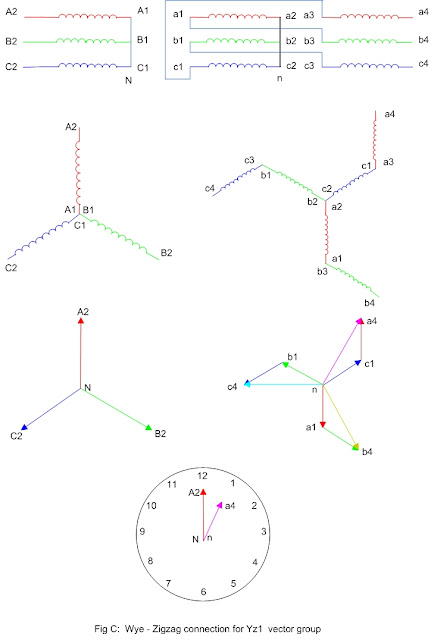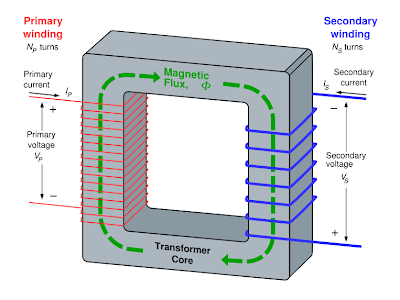Vector groups identify the winding connections and polarities of the primary and secondary. From a vector group one can determine the phase-shift between primary and secondary.
Transformer vector group depends upon:
- Removing harmonics: Dy connection – y winding nullifies 3rd harmonics, preventing it to be reflected on delta side.
- Parallel operations: All the transformers should have same vector group & polarity of the winding.
- Earth fault Relay: A Dd transformer does not have neutral. to restrict the earth faults in such systems, we may use zig zag wound transformer to create a neutral along with the earth fault relay..
- Type of Non Liner Load: systems having different types of harmonics & non linear Types of loads e.g. furnace heaters ,VFDS etc for that we may use Dyn11, Dyn21, Dyn31 configuration, wherein, 30 deg. shifts of voltages nullifies the 3rd harmonics to zero in the supply system.
- Type of Transformer Application: Generally for Power export transformer i.e. generator side is connected in delta and load side is connected in star. For Power export import transformers i.e. in Transmission Purpose Transformer star star connection may be preferred by some since this avoids a grounding transformer on generator side and perhaps save on neutral insulation. Most of systems are running in this configuration. May be less harmful than operating delta system incorrectly. Yd or Dy connection is standard for all unit connected generators.
Application of Transformer according to Vector Group
1.) Dyn11, Dyn1, YNd1, YNd11
- Common for distribution transformers.
- Normally Dyn11 vector group using at distribution system. Because Generating Transformer are YNd1 for neutralizing the load angle between 11 and 1.
- We can use Dyn1 at distribution system, when we are using Generator Transformer are YNd11.
- In some industries 6 pulse electric drives are using due to this 5thharmonics will generate if we use Dyn1 it will be suppress the 5th harmonics.
- Star point facilitates mixed loading of three phase and single phase consumer connections.
- The delta winding carry third harmonics and stabilizes star point potential.
- A delta-Star connection is used for step-up generating stations. If HV winding is star connected there will be saving in cost of insulation.
- But delta connected HV winding is common in distribution network, for feeding motors and lighting loads from LV side.
2.) Star-Star (Yy0 or Yy6)
- Mainly used for large system tie-up transformer.
- Most economical connection in HV power system to interconnect between two delta systems and to provide neutral for grounding both of them.
- Tertiary winding stabilizes the neutral conditions. In star connected transformers, load can be connected between line and neutral, only if
(a) the source side transformers is delta connected or
(b) the source side is star connected with neutral connected back to the source neutral. - In this transformers. Insulation cost is highly reduced. Neutral wire can permit mixed loading.
- Triple harmonics are absent in the lines. These triple harmonic currents cannot flow, unless there is a neutral wire. This connection produces oscillating neutral.
- Three phase shell type units have large triple harmonic phase voltage. However three phase core type transformers work satisfactorily.
- A tertiary mesh connected winding may be required to stabilize the oscillating neutral due to third harmonics in three phase banks.
3.) Delta – Delta (Dd 0 or Dd 6)
- This is an economical connection for large low voltage transformers.
- Large unbalance of load can be met without difficulty.
- Delta permits a circulating path for triple harmonics thus attenuates the same.
- It is possible to operate with one transformer removed in open delta or” V” connection meeting 58 percent of the balanced load.
- Three phase units cannot have this facility. Mixed single phase loading is not possible due to the absence of neutral.
4.) Star-Zig-zag or Delta-Zig-zag (Yz or Dz)
- These connections are employed where delta connections are weak. Interconnection of phases in zigzag winding effects a reduction of third harmonic voltages and at the same time permits unbalanced loading.
- This connection may be used with either delta connected or star connected winding either for step-up or step-down transformers. In either case, the zigzag winding produces the same angular displacement as a delta winding, and at the same time provides a neutral for earthing purposes.
- The amount of copper required from a zigzag winding in 15% more than a corresponding star or delta winding. This is extensively used for earthing transformer.
- Due to zig-zag connection (interconnection between phases), third harmonic voltages are reduced. It also allows unbalanced loading. The zigzag connection is employed for LV winding. For a given total voltage per phase, the zigzag side requires 15% more turns as compared to normal phase connection. In cases where delta connections are weak due to large number of turns and small cross sections, then zigzag star connection is preferred. It is also used in rectifiers.
5.) Zig-zag/ star (ZY1 or Zy11)
- Zigzag connection is obtained by inter connection of phases.4-wire system is possible on both sides. Unbalanced loading is also possible. Oscillating neutral problem is absent in this connection.
- This connection requires 15% more turns for the same voltage on the zigzag side and hence costs more. Hence a bank of three single phase transformers cost about 15% more than their 3-phase counterpart. Also, they occupy more space. But the spare capacity cost will be less and single phase units are easier to transport.
- Unbalanced operation of the transformer with large zero sequence fundamental mmf content also does not affect its performance. Even with Yy type of poly phase connection without neutral connection the oscillating neutral does not occur with these cores. Finally, three phase cores themselves cost less than three single phase units due to compactness.
6.) Yd5
- Mainly used for machine and main Transformer in large Power Station and Transmission Substation.
- The Neutral point can be loaded with rated Current.
7.) Yz-5
- For Distribution Transformer up to 250MVA for local distribution system.
- The Neutral point can be loaded with rated Current.
Application of Transformer according according to Uses
Step up Transformer: – It should be Yd1 or Yd11.Step down Transformer: – It should be Dy1 or Dy11.
Grounding purpose Transformer: – It should be Yz1 or Dz11.
Distribution Transformer: – We can consider vector group of Dzn0 which reduce the 75% of harmonics in secondary side.
Power Transformer: – Vector group is deepen on application for Example : Generating Transformer : Dyn1 , Furnace Transformer: Ynyn0.










